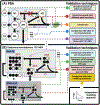Model validation and selection in metabolic flux analysis and flux balance analysis
- PMID: 37997613
- PMCID: PMC10922127
- DOI: 10.1002/btpr.3413
Model validation and selection in metabolic flux analysis and flux balance analysis
Abstract
13C-Metabolic Flux Analysis (13C-MFA) and Flux Balance Analysis (FBA) are widely used to investigate the operation of biochemical networks in both biological and biotechnological research. Both methods use metabolic reaction network models of metabolism operating at steady state so that reaction rates (fluxes) and the levels of metabolic intermediates are constrained to be invariant. They provide estimated (MFA) or predicted (FBA) values of the fluxes through the network in vivo, which cannot be measured directly. These fluxes can shed light on basic biology and have been successfully used to inform metabolic engineering strategies. Several approaches have been taken to test the reliability of estimates and predictions from constraint-based methods and to compare alternative model architectures. Despite advances in other areas of the statistical evaluation of metabolic models, such as the quantification of flux estimate uncertainty, validation and model selection methods have been underappreciated and underexplored. We review the history and state-of-the-art in constraint-based metabolic model validation and model selection. Applications and limitations of the χ2 -test of goodness-of-fit, the most widely used quantitative validation and selection approach in 13C-MFA, are discussed, and complementary and alternative forms of validation and selection are proposed. A combined model validation and selection framework for 13C-MFA incorporating metabolite pool size information that leverages new developments in the field is presented and advocated for. Finally, we discuss how adopting robust validation and selection procedures can enhance confidence in constraint-based modeling as a whole and ultimately facilitate more widespread use of FBA in biotechnology.
Keywords: constraint-based modeling; flux balance analysis; metabolic flux analysis; metabolic modeling; model selection; model validation.
© 2023 The Authors. Biotechnology Progress published by Wiley Periodicals LLC on behalf of American Institute of Chemical Engineers.
Conflict of interest statement
The authors have no conflicts of interest to disclose.
Figures


Update of
-
Model Validation and Selection in Metabolic Flux Analysis and Flux Balance Analysis.ArXiv [Preprint]. 2023 Mar 22:arXiv:2303.12651v1. ArXiv. 2023. Update in: Biotechnol Prog. 2024 Jan-Feb;40(1):e3413. doi: 10.1002/btpr.3413. PMID: 36994165 Free PMC article. Updated. Preprint.
Similar articles
-
Model Validation and Selection in Metabolic Flux Analysis and Flux Balance Analysis.ArXiv [Preprint]. 2023 Mar 22:arXiv:2303.12651v1. ArXiv. 2023. Update in: Biotechnol Prog. 2024 Jan-Feb;40(1):e3413. doi: 10.1002/btpr.3413. PMID: 36994165 Free PMC article. Updated. Preprint.
-
Short-Term Memory Impairment.2024 Jun 8. In: StatPearls [Internet]. Treasure Island (FL): StatPearls Publishing; 2025 Jan–. 2024 Jun 8. In: StatPearls [Internet]. Treasure Island (FL): StatPearls Publishing; 2025 Jan–. PMID: 31424720 Free Books & Documents.
-
Assessing the comparative effects of interventions in COPD: a tutorial on network meta-analysis for clinicians.Respir Res. 2024 Dec 21;25(1):438. doi: 10.1186/s12931-024-03056-x. Respir Res. 2024. PMID: 39709425 Free PMC article. Review.
-
Comparison of cellulose, modified cellulose and synthetic membranes in the haemodialysis of patients with end-stage renal disease.Cochrane Database Syst Rev. 2001;(3):CD003234. doi: 10.1002/14651858.CD003234. Cochrane Database Syst Rev. 2001. Update in: Cochrane Database Syst Rev. 2005 Jul 20;(3):CD003234. doi: 10.1002/14651858.CD003234.pub2. PMID: 11687058 Updated.
-
The FBA solution space kernel: introduction and illustrative examples.BMC Bioinformatics. 2025 Jul 17;26(1):182. doi: 10.1186/s12859-025-06216-y. BMC Bioinformatics. 2025. PMID: 40676517 Free PMC article.
Cited by
-
In vivo and in silico models of Drosophila for Parkinson's disease.FEBS J. 2025 Jun 1:10.1111/febs.70140. doi: 10.1111/febs.70140. Online ahead of print. FEBS J. 2025. PMID: 40451947 Review.
-
Metabolic models predict fotemustine and the combination of eflornithine/rifamycin and adapalene/cannabidiol for the treatment of gliomas.Brief Bioinform. 2024 Mar 27;25(3):bbae199. doi: 10.1093/bib/bbae199. Brief Bioinform. 2024. PMID: 38701414 Free PMC article.
-
Metabolic flux analysis in leaf metabolism quantifies the link between photorespiration and one carbon metabolism.Nat Plants. 2025 Sep 3. doi: 10.1038/s41477-025-02091-w. Online ahead of print. Nat Plants. 2025. PMID: 40903490
References
-
- Koffas MAG, Jung GY, Stephanopoulos G. Engineering metabolism and product formation in Corynebacterium glutamicum by coordinated gene overexpression. Metabolic Engineering. 2003;5(1):32–41. - PubMed
-
- Koffas MAG, Stephanopoulos G. Strain improvement by metabolic engineering: Lysine production as a case study for systems biology. Current Opinion in Biotechnology. 2005;16(3 SPEC. ISS.):361–6. - PubMed
-
- Becker J, Zelder O, Häfner S, Schröder H, Wittmann C. From zero to hero-Design-based systems metabolic engineering of Corynebacterium glutamicum for l-lysine production. Metabolic Engineering. 2011;13(2):159–68. - PubMed
Publication types
MeSH terms
Substances
Grants and funding
LinkOut - more resources
Full Text Sources

